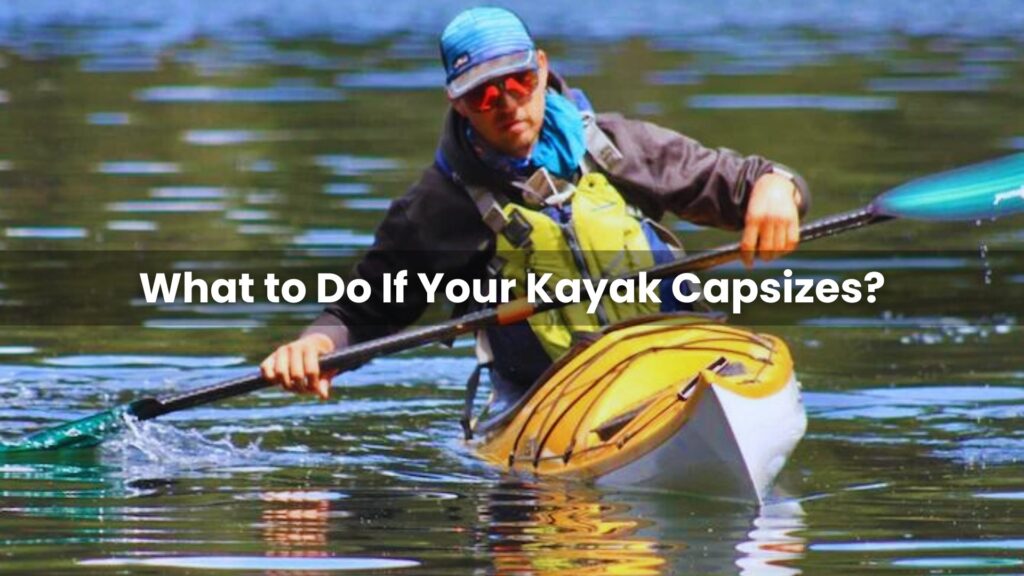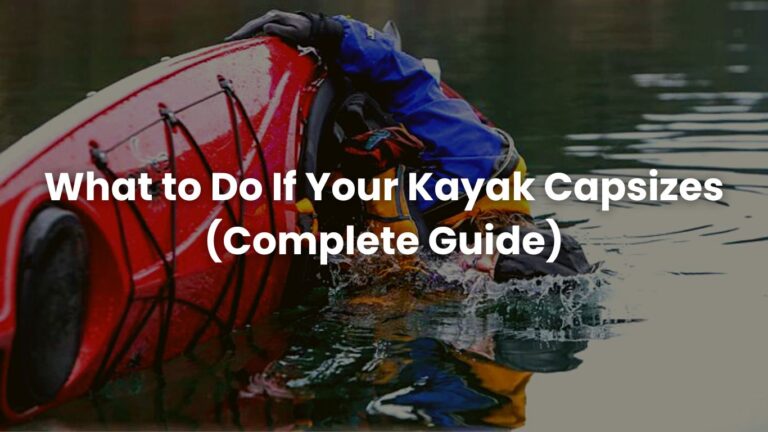Kayaking is a fun and exciting sport that can take you to places you’ve never seen before. But as with any water activity, there are some risks involved. One of the most common and scary situations that can happen to any kayaker, regardless of skill level or kayak type, is capsizing.
Capsizing is when your kayak flips over and you end up in the water. It can happen for various reasons, such as poor boat control, rough waters, wind, waves, or even a simple mistake. Capsizing can be a frightening and dangerous experience, especially if you’re not prepared for it.
That’s why it’s important to know what to do if your kayak capsizes. In this article, we’ll show you the steps involved in righting a kayak and re-entering it safely. We’ll also explain the common causes of capsizing, how to prevent it, and how to prepare for it. By the end of this article, you’ll have a better understanding of what to do if your kayak flips, how to recover from a kayak capsize, and how to avoid kayak capsizing tips.
Table of Contents
Why Do Kayaks Capsize?
To understand why kayaks capsize, we need to understand how kayaks stay upright and balanced in the water.
Kayaks have two types of stability: primary and secondary. Primary stability is how stable the kayak feels when it is flat on the water. Secondary stability is how stable the kayak feels when it is tilted on its side. Generally, kayaks with a wide and flat hull have more primary stability, while kayaks with a narrow and rounded hull have more secondary stability.
Poor boat control: If you don’t have good paddle strokes and balance skills, you might accidentally tip your kayak over by leaning too far, turning too sharply, or not bracing properly.
Rough waters: If you encounter waves, currents, or rapids that are too strong or unpredictable for your kayak or skill level, you might lose control of your kayak and get flipped over by the water force.
Wind: If you kayak in windy conditions, you might face resistance from the air that pushes your kayak off course or makes it harder to paddle. You might also catch more wind on your upper body or paddle, which can create a lever effect and tilt your kayak.
Obstacles: If you hit a submerged object, such as a rock, log, or sandbar, you might get stuck or bounce off, which can disrupt your kayak’s balance and momentum.
Human error: Sometimes, capsizing can be caused by a simple mistake, such as dropping your paddle, losing your grip, or getting distracted.
These are some of the common causes of capsizing, but they are not the only ones. Sometimes, capsizing can be unavoidable or unpredictable, such as when a rogue wave hits you, a fish jumps out of the water, or another kayaker bumps into you. That’s why it’s important to be prepared for any situation and know how to recover from a capsize.
How to Prevent Your Kayak From Capsizing?
While capsizing can happen to anyone, there are some things you can do to reduce the chances of it happening to you. Here are some tips and best practices on how to prevent your kayak from capsizing:
Choose the right kayak for your skill level and water conditions. Different kayaks have different levels of stability, maneuverability, and speed. For beginners, it’s better to choose a kayak that has more primary stability and is easier to control. For experienced kayakers, it’s better to choose a kayak that has more secondary stability and is faster and more responsive. You should also consider the type of water you’re kayaking in, such as calm lakes, choppy seas, or swift rivers, and choose a kayak that is suitable for that environment.
Practice your paddle strokes and balance skills. One of the best ways to prevent capsizing is to master the basic paddle strokes, such as forward, backward, sweep, draw, and rudder strokes. These strokes will help you steer, turn, and stop your kayak effectively. You should also practice your balance skills, such as edging, leaning, and bracing. These skills will help you adjust your kayak’s position and stability in the water. You can practice these skills in a safe and calm area, such as a pool or a lake, before venturing into more challenging waters.
Wear a life jacket and a sprayskirt. A life jacket is a must-have for any kayaker, as it will keep you afloat and protect you from drowning in case of a capsize. A sprayskirt is a cover that attaches to the cockpit of your kayak and prevents water from entering it. A sprayskirt will help you stay dry and warm, and also make it easier to right your kayak and re-enter it after a capsize. You should always wear a life jacket and a sprayskirt that fit you well and are compatible with your kayak.
Secure your belongings in waterproof compartments. If you’re carrying any items with you, such as a camera, a phone, a wallet, or a snack, you should store them in waterproof compartments or bags inside your kayak. This will prevent them from getting wet, damaged, or lost in case of a capsize. You should also avoid overloading your kayak with unnecessary or heavy items, as this can affect your kayak’s balance and performance.
Pay attention to the surroundings. Another way to prevent capsizing is to be aware of the weather and water conditions, and how they can change quickly and unexpectedly. You should check the weather forecast and the tide chart before you go kayaking, and avoid kayaking in stormy, windy, or foggy conditions. You should also keep an eye on the waves, currents, and rapids, and avoid kayaking in areas that are too rough or shallow for your kayak or skill level. You should also watch out for any obstacles, such as rocks, logs, bridges, or other boats, and steer clear of them.
What to Do If Your Kayak Capsizes?

If you find yourself in a capsizing situation, don’t panic. The most important thing is to stay calm and follow these steps:
Perform a wet exit: A wet exit is when you exit your kayak while it is upside down in the water. To do this, you need to release your sprayskirt, lean forward, and push yourself out of the cockpit. You should also keep hold of your paddle, as you will need it later. If you have trouble getting out of your kayak, you can use a quick-release buckle or a knife to cut your sprayskirt. You should also practice wet exits in a safe and controlled environment before going kayaking.
Right your kayak: Once you are out of your kayak, you need to flip it back to its upright position. To do this, you can use one of these methods:
Paddle float method: A paddle float is a device that attaches to the end of your paddle and inflates to create a buoyant support. To use this method, you need to attach the paddle float to one end of your paddle, secure the other end to the cockpit rim of your kayak, and use the paddle as a lever to lift and flip the kayak.
Paddle leash method: A paddle leash is a cord that connects your paddle to your kayak, preventing it from drifting away. To use this method, you need to grab the paddle leash near the end of your paddle, pull it over the hull of your kayak, and use it to flip the kayak over.
Rescue stirrup method: A rescue stirrup is a strap that hangs from the cockpit of your kayak and creates a foothold for you to climb back in. To use this method, you need to grab the rescue stirrup, place your foot in it, and use your leg strength to flip the kayak over.
Kayak towline method: A kayak towline is a rope that connects your kayak to another kayak, allowing you to tow or be towed by another kayaker. To use this method, you need to attach the kayak towline to the bow or stern of your kayak, and ask another kayaker to pull it and flip your kayak over.
These are the basic steps involved in recovering from a kayak capsize. However, you should always be aware of your surroundings and the conditions, and adapt your actions accordingly. For example, if you are in cold water, you should try to re-enter your kayak as quickly as possible to avoid hypothermia. If you are in rough water, you should try to stay close to your kayak and paddle, and avoid getting separated from them. If you are in a group, you should try to communicate and help each other, and use assisted-rescue techniques if necessary.
How to Prepare for a Capsized Kayak?
Being prepared for a capsized kayak can make a big difference in your safety and comfort. It can also reduce the risk of injury, hypothermia, or drowning, and increase the chances of recovery and rescue. Here are some ways to prepare for a capsized kayak:
Take a kayak safety course. A kayak safety course will teach you the essential skills and knowledge you need to kayak safely and confidently. You will learn how to perform wet exits, righting and re-entering techniques, self-rescue and assisted-rescue methods, and emergency procedures. You will also learn how to choose the right kayak, paddle, life jacket, and sprayskirt for your needs and preferences.You can find kayak safety courses online or in your local area, and they are usually offered by kayak clubs, organizations, or instructors.
Practice your skills and techniques. Even if you have taken a kayak safety course, you should still practice your skills and techniques regularly and frequently. This will help you improve your proficiency and confidence, and also refresh your memory and muscle memory. You should practice your skills and techniques in a safe and controlled environment, such as a pool or a lake, before venturing into more challenging waters. You should also practice with a partner or a group, so that you can help each other and learn from each other.
Carry emergency gear and communication devices. Another way to prepare for a capsized kayak is to carry emergency gear and communication devices that can help you in a crisis. Some of the emergency gear you should carry include a whistle, a flashlight, a flare, a first-aid kit, a knife, a compass, a map, and a survival kit. Some of the communication devices you should carry include a cell phone, a GPS, a radio, or a satellite phone. You should store these items in waterproof compartments or bags inside your kayak, and make sure they are fully charged and functional. You should also know how to use them properly and effectively.
FAQS About What to Do If Your Kayak Capsizes
How do I prevent my kayak from capsizing?
You can prevent your kayak from capsizing by choosing the right kayak for your skill level and water conditions, practicing your paddle strokes and balance skills, wearing a life jacket and a sprayskirt, securing your belongings in waterproof compartments, and paying attention to the surroundings.
What Should I Do If my Kayak Capsizes?
If your kayak capsizes, you should stay calm and follow these steps: perform a wet exit, right your kayak, and re-enter your kayak. You should also use the appropriate methods and techniques for each step, such as using a paddle float, a paddle leash, a rescue stirrup, or a kayak towline.
How Do I Perform a Wet Exit?
A wet exit is when you exit your kayak while it is upside down in the water. To perform a wet exit, you need to release your sprayskirt, lean forward, and push yourself out of the cockpit. You should also keep hold of your paddle, as you will need it later.
How Do I Right My Kayak?
To right your kayak, you need to flip it back to its upright position. To do this, you can use one of these methods: paddle float method, paddle leash method, rescue stirrup method, or kayak towline method. You should also choose the method that suits your situation and equipment.
How Do I Re-Enter My Kayak?
To re-enter your kayak, you need to get back in it. To do this, you can use one of these methods: paddle float method, paddle leash method, rescue stirrup method, or kayak towline method. You should also choose the method that suits your situation and equipment.
How Do I Prepare for a Capsized Kayak?
To prepare for a capsized kayak, you should take a kayak safety course, practice your skills and techniques, carry emergency gear and communication devices, check the weather and water conditions, and inform someone of your plans. You should also be aware of the risks and challenges of kayaking, and be ready to handle any situation.
Conclusion
In this guide, we have learned what to do if your kayak capsizes, why kayaks capsize, how to prevent capsizing, and how to prepare for a capsized kayak. We have also covered the steps and methods involved in performing a wet exit, righting a kayak, and re-entering a kayak safely. By following these tips and techniques, you can kayak with more confidence and enjoyment, and handle any capsizing situation with calmness and competence.
We hope you found this article helpful and informative. If you have any questions, comments, or feedback, please feel free to share them in the section below. We would love to hear from you and learn from your experiences.

Nigel Foster, born in 1952, is an esteemed sea kayaker, known for being the youngest to kayak around Iceland. His journey in kayaking started at 15 in Brighton, England. With a career beginning as a trainee instructor in Sussex, he later pursued teaching after attending Redland College, Bristol.
Foster’s notable expeditions include navigating the challenging waters of Newfoundland and the Hudson Strait. Despite facing intense conditions, his passion for kayaking never waned. He holds several British Canoe Union qualifications and has significantly contributed to the kayaking community through teaching and committee work.
In 1985, Foster expanded his horizons by assisting an expedition in Iceland and later founded his own kayaking business, sharing his expertise globally.
